
Suldal is a municipality in the northeast corner of Rogaland county, Norway. It is located in the traditional district of Ryfylke. Since 1965, the administrative centre of Suldal is the village of Sand i Ryfylke. Other villages in Suldal include Haugsland, Jelsa, Marvik, Nesflaten, and Suldalsosen.
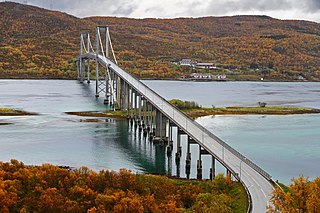
The Tjeldsund Bridge is a suspension road bridge that crosses the Tjeldsundet strait between the mainland and the island of Hinnøya in Troms county, Norway. The bridge is 1,007 metres (3,304 ft) long, the main span is 290 metres (950 ft), and the maximum clearance to the sea is 41 metres (135 ft). The bridge has 32 spans.

The Gimsøystraumen Bridge is a cantilever road bridge that crosses the Gimsøystraumen strait between the islands of Austvågøya and Gimsøya in Vågan Municipality in Nordland county, Norway.

The Gjemnessund Bridge is a suspension bridge that crosses the Gjemnessundet strait between the mainland and the island of Bergsøya in the municipality of Gjemnes in Møre og Romsdal county, Norway. The 1,257-metre-long (4,124 ft) bridge was the longest suspension bridge in Norway until the opening of the Hardanger Bridge in 2013, although it did not have the longest span, being eclipsed by the Askøy Bridge.
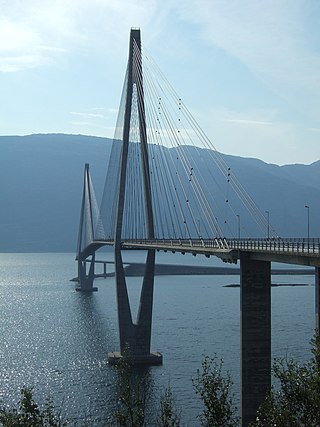
The Helgeland Bridge is a cable-stayed bridge that crosses the Leirfjorden between the mainland and the island of Alsta in Nordland county, Norway. The town of Sandnessjøen is located just southwest of the bridge on the island.
The Skarnsund Bridge is a 1,010-metre (3,310 ft) long concrete cable-stayed bridge that crosses the Skarnsundet strait, in the municipality of Inderøy in Trøndelag county, Norway. When finished in 1991, it replaced the Vangshylla–Kjerringvik Ferry and it gives the communities in the municipalities of Mosvik and Leksvik easier access to the central areas of Innherred. The bridge is the only road crossing of the Trondheimsfjord, and is located along Norwegian County Road 755.

The Efjord Bridges are a series of three bridges that cross the 1.7-kilometre (1.1 mi) wide Efjorden in Narvik Municipality in Nordland county, Norway. The bridges are a part of the European route E6 highway and they were opened in 1969. The three bridges connect the mainland sides of the fjord via two small islands in the fjord. The easternmost bridge is the Kjerringstraumen Bridge, then comes the Mellastraumen Bridge, and finally the Sørstraumen Bridge.

The Kjellingstraumen Bridge is a suspension bridge that crosses the Kjellingsundet strait at the mouth of the Beiar Fjord in Gildeskål Municipality in Nordland county, Norway. The 662-metre (2,172 ft) long bridge carries Norwegian County Road 17. The bridge was opened in 1975 and the longest span is 260 metres (850 ft).
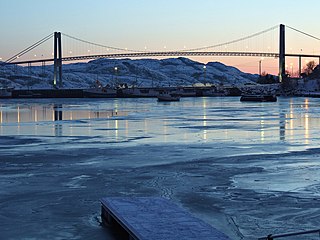
The Nærøysund Bridge is a suspension bridge that crosses the Nærøysundet strait between the islands of Marøya and Innervikna in Nærøysund in Trøndelag county, Norway. It is located about 1 kilometre (0.62 mi) south of the town of Rørvik. Together with the Marøysund Bridge, it connects the islands of Vikna to the mainland. The Nærøysund Bridge is 701 metres (2,300 ft) long, the main span is 325 metres (1,066 ft), and the maximum clearance to the sea is 41 metres (135 ft). The bridge has 17 spans. The Nærøysund Bridge was opened in 1981, when it briefly held the title of the world's longest cable-stay bridge.

The Bergsøysund Bridge is a pontoon bridge that crosses the Bergsøysundet strait between the islands of Aspøya and Bergsøya in Møre og Romsdal county, Norway. The bridge is 931 metres (3,054 ft) long, the longest span is 106 metres (348 ft), and the maximum clearance to the sea is 6 metres (20 ft). The bridge has 13 spans.

European route E39 is the designation of a 1,330 kilometres (830 mi) north–south road in Norway and Denmark from Klett, just south of Trondheim, to Aalborg via Bergen, Stavanger and Kristiansand. In total, there are nine ferries, more than any other single road in Europe.
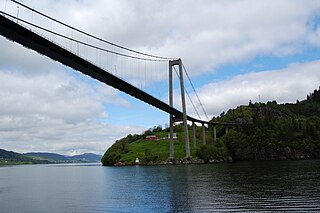
The Osterøy Bridge is a suspension bridge in Vestland county, Norway. The bridge connects the Kvisti farm area on the island of Osterøy in Osterøy Municipality with the Herland farm area on the mainland in Bergen Municipality east of the city of Bergen. The bridge is the third largest suspension bridge in Norway. It is part of Norwegian County Road 566.

Erfjord is a former municipality in Rogaland county, Norway. The 132-square-kilometre (51 sq mi) municipality existed from 1914 until 1965. It encompassed the area around the Erfjorden in the southwestern part of the present-day municipality of Suldal. The administrative centre of the municipality was the village of Hålandsosen, where the Erfjord Church is located.
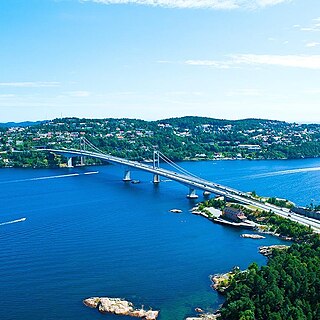
The Varodd Bridges are two parallel cantilever bridges in Kristiansand municipality, in Agder county, Norway, and they cross the Topdalsfjorden. They are named after the peninsula on the western shore. It goes from Vige and ends in Søm in Kristiansand. The bridges carry the European route E18 highway over the fjord.

Lysefjord Bridge Norwegian: Lysefjordbrua is a suspension bridge over the Lysefjorden in Rogaland county, Norway. The bridge connects the municipalities of Strand and Sandnes. Construction on the 639-metre-long (2,096 ft) bridge began in 1995 and was finished in 1997 at a cost of 150 million kr.

The Hardanger Bridge is a suspension bridge across the Eidfjorden branch off of the main Hardangerfjorden in Vestland county, Norway. The bridge connects the municipalities of Ullensvang and Ulvik. It replaced a ferry connection between Bruravik and Brimnes, and thereby shortens the driving time between Oslo and Bergen. It is the longest suspension bridge in Norway.

The Fyksesund Bridge is a suspension road bridge in Vestland county, Norway.
The Storfjord Bridge is a proposed suspension bridge that would span the Storfjorden in Sunnmøre, Norway. If built, it would be 3,600 metres (11,800 ft) long and have a main span of 2,300 metres (7,500 ft). This would make it the longest spanned bridge in the world, easily surpassing the 1915 Çanakkale Bridge, which has a main span of 2,023 metres (6,637 ft). The plans have been developed by Aas-Jakobsen for a Storfjordsambandet, a company which aims to toll finance the bridge. According to Rolf M. Larssen of Aas-Jakobsen, there is a larger challenge securing sufficient funding than technically building the bridge. It is estimated to cost 4.3 billion Norwegian krone.

Erfjorden is a fjord in the municipalities Suldal and Hjelmeland in Rogaland county, Norway. The 16-kilometre (9.9 mi) long fjord begins at the small village of Tysse in Suldal and heads south past the village of Hålandsosen before making a sharp turn to the west before emptying into the larger Nedstrandsfjorden. The Erfjord Bridge crosses the fjord, just north of Hålandsosen. The innermost part of the fjord is sometimes referred to as the Tyssefjorden.
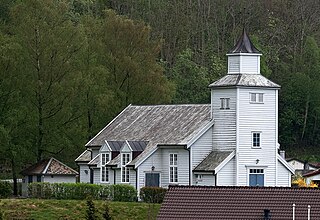
Hålandsosen is a village in Suldal municipality in Rogaland county, Norway. The village is located along the eastern shore of the Erfjorden, about 13 kilometres (8.1 mi) east of the village of Jelsa and about 15 kilometres (9.3 mi) south of the municipal centre of Sand. The Norwegian National Road 13 runs through the village, and the Erfjord Bridge lies just north of the village. It is the only bridge over the Erfjorden.



















